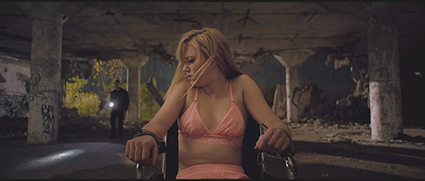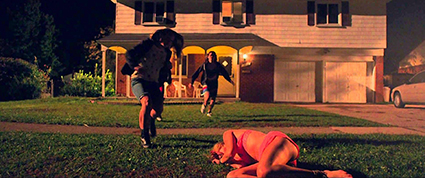Horror: intensified but refined
Katerina Sakkas: It Follows

It Follows
After minimal credits, It Follows opens on an escape: a young woman running from a house down an evening street in leafy suburban America. She looks back in terror every so often but neither we, nor those she passes can see the threat. A visceral bass booming accompanies her flight, like a heartbeat. She scrambles into her car and drives to the beach. We see her in a beautiful long shot with the dark sea behind. She leaves her father a tearful phone message.
Next shot: the following morning, the woman’s body on the sand, one high-heeled leg bent at a grotesque angle. After this horrific prelude, we’re back in suburbia—large two-storey houses, stretches of unfenced lawn. Jay (Maika Monroe), our 20-ish protagonist, floats in a small above-ground pool. From here on, It Follows will build terror with exquisite deliberation, displaying a mastery of those liminal moments when the fabric of reality wears thin.
Much of the film’s horror is achieved through narrative suggestion rather than shock effects. Take a scene early on when Jay is on a movie date with Hugh (Jake Weary), someone she clearly likes but doesn’t know all that well. They play a game: taking turns, each of them picks someone in the crowd they’d want to trade places with, while the other guesses whom they’ve picked and why. As they seat themselves, it’s Hugh’s turn to guess Jay’s choice. “The girl in the yellow dress,” he hazards, but there’s no one standing where he’s pointing. A couple of beats. “Is this a joke?” Jay asks. Hugh abruptly suggests they leave, citing sickness. This clever conjuring of a presence we cannot see instantly warps our sense of a secure reality.
Hingeing on a simple premise—the notion of a sexually transmitted evil that assumes human form and follows its victim—It Follows is a very frightening film. Its greatest power lies in the way it creates a sense of two worlds coexisting: the everyday world of college students and suburbia and movie dates overlaid by another reality beyond our understanding. Disasterpeace’s immersive synth soundtrack constantly evokes the otherworldly, shifting between ominous (the booming in the first scene) and something numinous (a sweet chiming as Jay gets ready for her date).

It Follows
Mike Gioulakis’ cinematography repeatedly returns to the long view of a figure or figures centred in a landscape. Nature is shown in crystalline detail. Night scenes are lit as atmospherically as an Edward Hopper painting. The composition of shots often recalls the elaborately sinister tableaux of photographer Gregory Crewdson. We’re in the territory of the Sublime here, where beauty is inextricably linked with terror and awe. Nineteenth century Romantic painters found the Sublime in nature and ruins. It Follows gives us lingering shots of leaves as well as the contemporary urban ruins of Detroit City (employed to similar atmospheric effect by Jim Jarmusch in his 2013 vampire film Only Lovers Left Alive).
This is the aesthetic antithesis of much contemporary horror, particularly the found-footage genre, which pursues a documentary frisson through small-screen grunginess, creating fear of what lies outside of the frame, or beneath the pixellation. The cinematic expansiveness of It Follows, on the other hand, increases our paranoia precisely because we can see so much. When Jay is outside among other people, the eye immediately scans the distance in a “Where’s Wally” manner for suspect figures. The film plays with this tendency by throwing out an occasional red herring, as well as, on one occasion, a possible threat that Jay doesn’t even notice. The use of slow 360-degree rotating shots further emphasises the fact that for the duration of the film, the viewer is enclosed in a big, sublime world encompassing unfathomable terrors.
It Follows (2014), writer, director David Robert Mitchell, cinematography Mike Gioulakis, score Rich Vreeland (as Disasterpeace)
RealTime issue #127 June-July 2015 pg. 23






